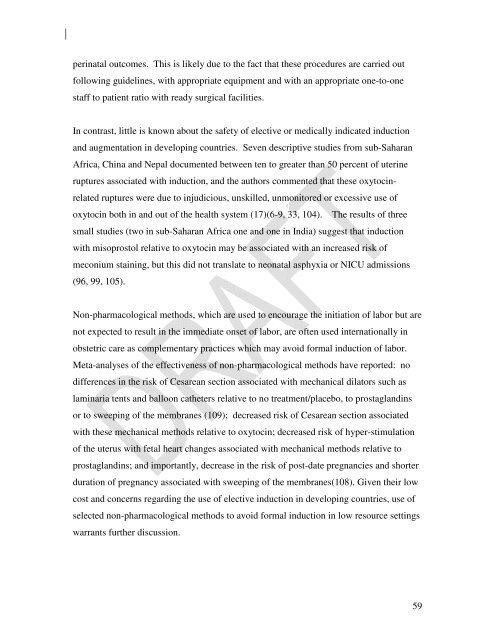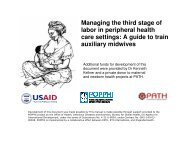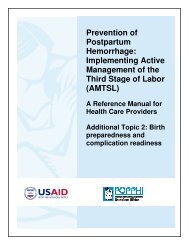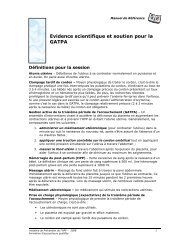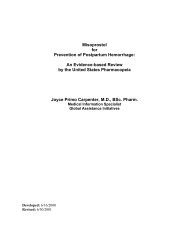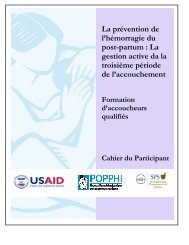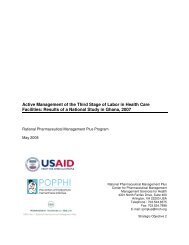Use of oxytocin and misoprostol for induction or ... - POPPHI
Use of oxytocin and misoprostol for induction or ... - POPPHI
Use of oxytocin and misoprostol for induction or ... - POPPHI
Create successful ePaper yourself
Turn your PDF publications into a flip-book with our unique Google optimized e-Paper software.
perinatal outcomes. This is likely due to the fact that these procedures are carried out<br />
following guidelines, with appropriate equipment <strong>and</strong> with an appropriate one-to-one<br />
staff to patient ratio with ready surgical facilities.<br />
In contrast, little is known about the safety <strong>of</strong> elective <strong>or</strong> medically indicated <strong>induction</strong><br />
<strong>and</strong> augmentation in developing countries. Seven descriptive studies from sub-Saharan<br />
Africa, China <strong>and</strong> Nepal documented between ten to greater than 50 percent <strong>of</strong> uterine<br />
ruptures associated with <strong>induction</strong>, <strong>and</strong> the auth<strong>or</strong>s commented that these <strong>oxytocin</strong>related<br />
ruptures were due to injudicious, unskilled, unmonit<strong>or</strong>ed <strong>or</strong> excessive use <strong>of</strong><br />
<strong>oxytocin</strong> both in <strong>and</strong> out <strong>of</strong> the health system (17)(6-9, 33, 104). The results <strong>of</strong> three<br />
small studies (two in sub-Saharan Africa one <strong>and</strong> one in India) suggest that <strong>induction</strong><br />
with <strong>misoprostol</strong> relative to <strong>oxytocin</strong> may be associated with an increased risk <strong>of</strong><br />
meconium staining, but this did not translate to neonatal asphyxia <strong>or</strong> NICU admissions<br />
(96, 99, 105).<br />
Non-pharmacological methods, which are used to encourage the initiation <strong>of</strong> lab<strong>or</strong> but are<br />
not expected to result in the immediate onset <strong>of</strong> lab<strong>or</strong>, are <strong>of</strong>ten used internationally in<br />
obstetric care as complementary practices which may avoid <strong>f<strong>or</strong></strong>mal <strong>induction</strong> <strong>of</strong> lab<strong>or</strong>.<br />
Meta-analyses <strong>of</strong> the effectiveness <strong>of</strong> non-pharmacological methods have rep<strong>or</strong>ted: no<br />
differences in the risk <strong>of</strong> Cesarean section associated with mechanical dilat<strong>or</strong>s such as<br />
laminaria tents <strong>and</strong> balloon catheters relative to no treatment/placebo, to prostagl<strong>and</strong>ins<br />
<strong>or</strong> to sweeping <strong>of</strong> the membranes (109); decreased risk <strong>of</strong> Cesarean section associated<br />
with these mechanical methods relative to <strong>oxytocin</strong>; decreased risk <strong>of</strong> hyper-stimulation<br />
<strong>of</strong> the uterus with fetal heart changes associated with mechanical methods relative to<br />
prostagl<strong>and</strong>ins; <strong>and</strong> imp<strong>or</strong>tantly, decrease in the risk <strong>of</strong> post-date pregnancies <strong>and</strong> sh<strong>or</strong>ter<br />
duration <strong>of</strong> pregnancy associated with sweeping <strong>of</strong> the membranes(108). Given their low<br />
cost <strong>and</strong> concerns regarding the use <strong>of</strong> elective <strong>induction</strong> in developing countries, use <strong>of</strong><br />
selected non-pharmacological methods to avoid <strong>f<strong>or</strong></strong>mal <strong>induction</strong> in low resource settings<br />
warrants further discussion.<br />
59


